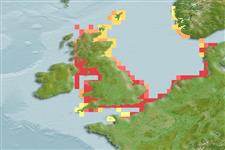Malacostraca |
Decapoda |
Palaemonidae
Environment: milieu / climate zone / djupintervall / distribution range
Ekologi
Katadrom; sötvatten; brackvatten; djupintervall 0 - 17 m (Ref. 101283). Temperate, preferred 11°C (Ref. 107945); 61°N - 27°N, 14°W - 42°E
Eastern Atlantic and the Mediterranean. Introduced in Baltic and Black Sea.
Length at first maturity / Size / Weight / Age
Könsmognad: Lm ? range ? - ? cm Max length : 7.0 cm TL hane/ej könsbestämd; (Ref. 8)
Common in European estuaries. Mostly inhabits freshwater throughout the year but migrates to estuarine brackish waters to reproduce (Ref. 82147).
Life cycle and mating behavior
Könsmognad | Reproduktion | Lek | Eggs | Fecundity | Larvae
Inhabits freshwater but migrates o estuarine brackish waters to reproduce. The development of the whole larval stage takes place in mid estuarine waters (Ref. 82147); juveniles migrates back to freshwater (Ref. 82145).
Grabowski, M. 2006 Rapid colonization of the Polish Baltic coast by an Atlantic palaemonid shrimp Palaemon elegans Rathke, 1837. Aquatic Invasions 1(3):116-123. (Ref. 2756)
IUCN Red List Status
(Ref. 130435: Version 2025-1)
CITES status (Ref. 108899)
Not Evaluated
Not Evaluated
Threat to humans
Human uses
Fiskeri: kommersiell; bete: occasionally
FAO - fiskeri: landings | FishSource | Sea Around Us
Verktyg
Ytterligare information
Trophic EcologyFood items (preys)
Födosammansättning
Födointag
Predatorer
PhysiologySyreförbrukning
Human RelatedStamps, coins, misc.
Internet-källor
Estimates based on models
Preferred temperature
(Ref.
115969): 10.6 - 12.5, mean 11.5 (based on 86 cells).
Resiliens
Hög, lägsta populationsfördubblingstid mindre än 15 månader (K=0.51-0.62).
Fishing Vulnerability
Low vulnerability (23 of 100).
Climate Vulnerability
High vulnerability (64 of 100).
Nutrients : Calcium = 109 [35, 184] mg/100g; Iron = 1.59 [1.21, 1.97] mg/100g; Protein = 20.2 [19.2, 21.3] %; Omega3 = 0.285 [0.185, 0.386] g/100g; Selenium = 48.3 [-31.7, 128.3] μg/100g; VitaminA = 0 μg/100g; Zinc = 1.79 [1.17, 2.40] mg/100g (wet weight); based on
nutrient studies.
